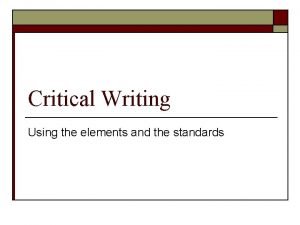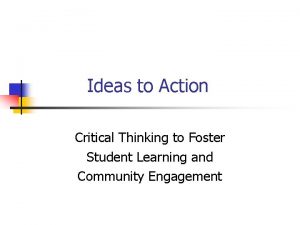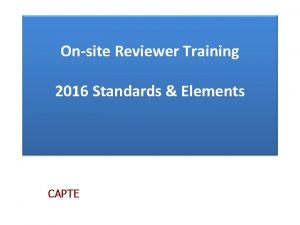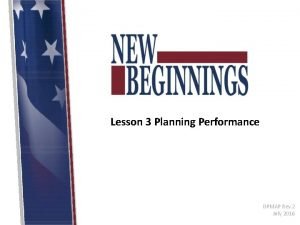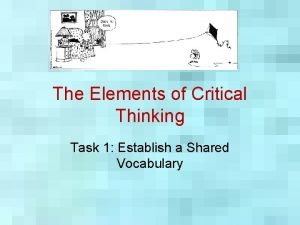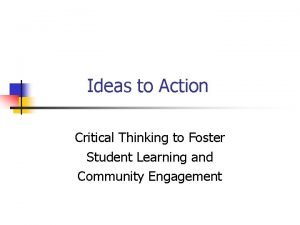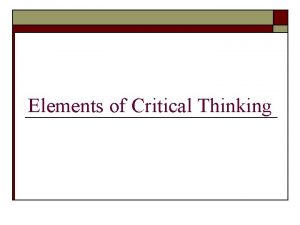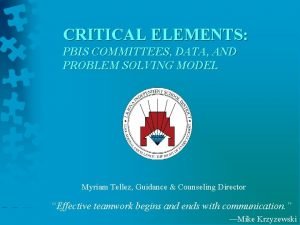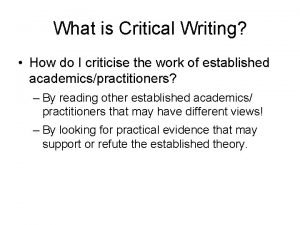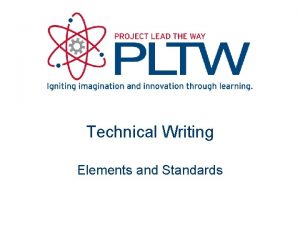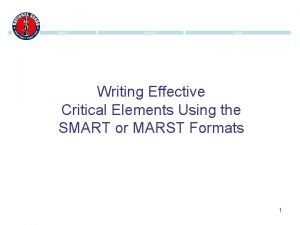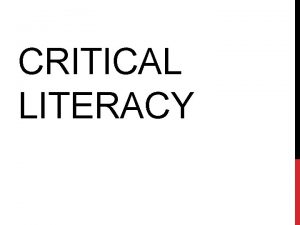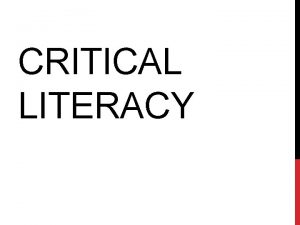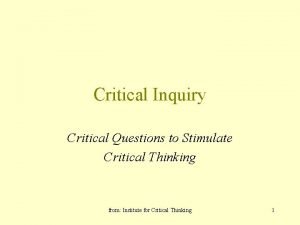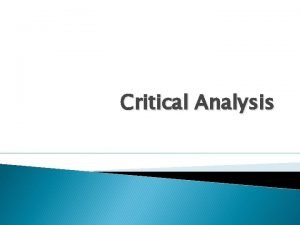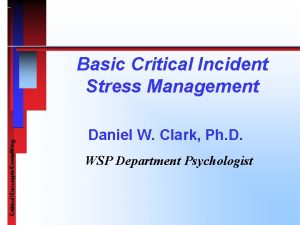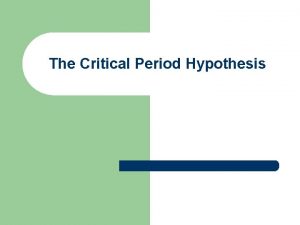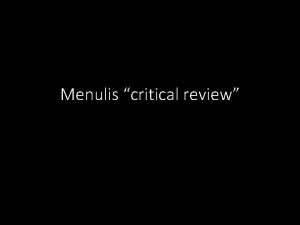Critical Writing Using the elements and the standards















- Slides: 15

Critical Writing Using the elements and the standards

Start at the beginning o Analyze the Q at I n n What is the question really asking of you? What seems to be its purpose? What is the context of the question? o o n n Consider course objectives, recent readings and discussions Current and/or historical events What system(s) do you need to use to answer the question? What information do you need?

Continue around the circle (as Chris did for getting married) o What assumptions do you make about the topic? n o o What do you take for granted or already know? What points of view should be considered? What concepts need to be defined and addressed? n Which have the most explanatory power?

Continue around the circle o What seem to be the potential implications and consequences for the topic? o What interpretations do you make? n n (vs. what others have told you) What conclusions can you draw about what you already know?

Determine what you need to include o What else do you need to consider to answer the question sufficiently? n n Which are the most important aspects of your analysis? How deeply do you need to address each item? How much time do you have? (such as for an inclass essay) Are there maximum and minimum word counts?

Perform a standards check o Is your information accurate n o Do you cover enough breadth? n n o Is your analysis complex enough? Or does it just scratch the surface and communicate the obvious? Is all the information relevant? Do you have sufficient information? n o Have you considered all viewpoints? Will you have an unbiased analysis? Do you need to delve deeper? n o Is it all from a credible and reliable source? Do you need more in some areas? And so on. .

Organize your paper o Determine the main points you will make n n What is most important for making your case? Do you need to include all of the elements you have identified? o o o Which are most relevant? Which provide the strongest support or argument? Write a thesis statement n n Distills your stance into 1 -2 sentences Never asks question

Create an outline o o Highly recommended Saves time Organizes ideas and information Allows writer to write first draft freely n n o Can focus mind fully on ideas and arguments Frees mind from organizational/structural distractions Check for weak points that might need additional support

Writing the paper o Strategy (Time is your friend. ) n n n Complete first draft in one sitting, uninterrupted Benefit: continuous train of thought usually higher quality than the stop and start method Put paper aside for another day to review with a fresh mind o o Better identify gaps in information and clarity Better recognize mechanical errors (precision)

Writing the paper o Introduction n Identifies the topic Orients the reader to the Q at I and the purpose Includes thesis

Writing the paper o Body n Paragraph level (remember the SEE-I technique) o o o One topic or argument per paragraph Include a topic sentence that states your claim or argument (S) Elaborate on that argument (E) (may require more than one paragraph to fully explicate) Use examples or evidence to support the argument (E) Illustrate when necessary (I)

Writing the paper o Body n Overall structure o Include smooth transitions between paragraphs by n n o o Ending each paragraph with a sentence that ties to the topic sentence and to thesis Never concluding a paragraph with the topic for the next paragraph Always start with your weakest argument and work toward the strongest (classical argument) Always identify and refute counterarguments or acknowledge their merit, if appropriate to do so (Rogerian argument)

Writing the paper o Conclusion n Can write at the same time as the body or at a later sitting Review the points you make in the paper to draw everything together for the reader Include the “so what? ” which speaks to the significance of the issue o o Tells audience why the topic is important Often relates to implications and consequences

Revise again o o One revision catches the major stuff (relevance, sufficiency, depth, and breadth) Second revision provides opportunity to improve clearness, precision, and accuracy n n Clear connections between ideas and evidence Syntax, wordiness, sentence structure Word choices Transitions

Final thoughts o o Use time to your advantage You know what you think n o o o Explain why (consider impediments and assumptions, among other elements) Your audience doesn’t know what you think (consider clearness) Your audience also doesn’t know as much about the topic as you know (consider sufficiency and depth) Your audience has his/her own viewpoint (consider breadth)
 Critical semi critical and non critical instruments
Critical semi critical and non critical instruments Semicritical
Semicritical Elements of critical writing
Elements of critical writing Slidetodoc.com
Slidetodoc.com Factors necessary for service standards are
Factors necessary for service standards are Standards of critical thinking
Standards of critical thinking Capte standards and elements
Capte standards and elements Planning appraisal example
Planning appraisal example Elements of critical thinking
Elements of critical thinking 5 components of critical thinking
5 components of critical thinking Elements of critical thinking
Elements of critical thinking Pbis critical elements
Pbis critical elements Icao critical elements
Icao critical elements Elements of art color
Elements of art color What is critical writing
What is critical writing Essential elements of state
Essential elements of state


